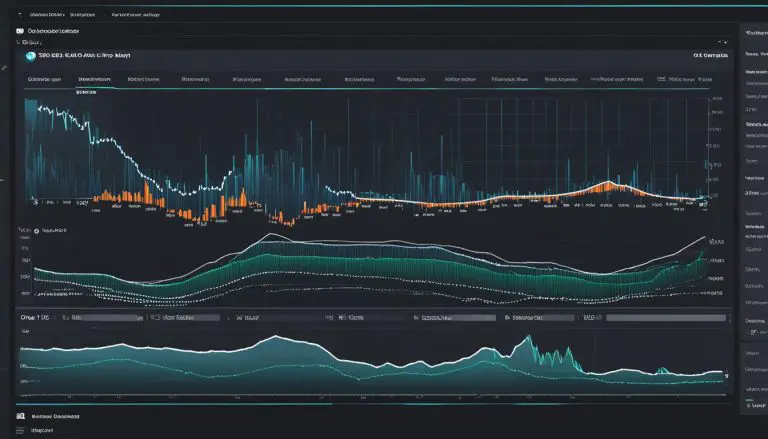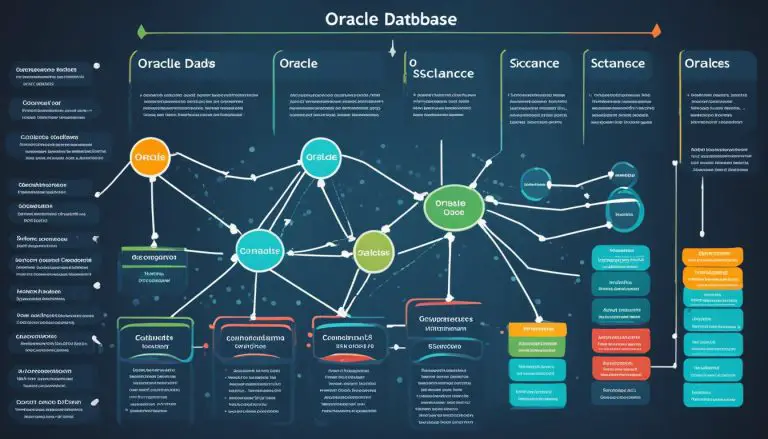In a Nutshell: What is Python
In this article, I will guide you through the basics of Python, providing a simple and straightforward explanation of this popular programming language. Whether you are a beginner or an experienced programmer, understanding the fundamentals of Python is essential for unleashing its full potential.
Python is an object-oriented programming language renowned for its simplicity and readability. It offers a wide range of applications and is favored by developers worldwide. Let’s dive into the world of Python and explore its features, syntax, and why it stands out among other programming languages.
Key Takeaways:
- Python is an object-oriented programming language known for its simplicity and readability.
- It is widely used for various applications and is suitable for both beginners and experienced programmers.
- Python’s clean syntax and extensive standard library make it accessible and efficient.
- It supports multiple programming paradigms, adding to its versatility.
- Python has a large and active community, providing abundant support and resources for developers.
What Makes Python Stand Out Among Programming Languages?
In the world of programming languages, Python shines as a highly acclaimed and widely used choice. Its popularity can be attributed to several standout features and qualities that set it apart from other programming languages.
One of the key factors that make Python stand out is its clean and easily readable syntax. Unlike some other languages that require complex syntax with brackets and symbols, Python emphasizes simplicity and clarity. The use of indentation to define blocks of code reduces visual clutter and makes the code more accessible to developers.
Python’s clean syntax reduces complexity and makes the code more readable, allowing developers to focus on problem-solving rather than deciphering convoluted syntax.
Furthermore, Python offers a vast standard library that provides a wide range of modules and functions. This extensive collection of resources allows developers to leverage pre-built solutions and accelerate their development process. With a comprehensive set of tools at their disposal, developers can build applications without reinventing the wheel.
Python’s versatility is another standout attribute. It supports multiple programming paradigms, including procedural, functional, and object-oriented programming. This flexibility enables developers to choose the most suitable approach for their projects, making Python a versatile language that can be used for a wide variety of applications.
Table: Python Features
| Feature | Description |
|---|---|
| Readability | Python’s clean and easily readable syntax reduces complexity and enhances code comprehension. |
| Extensive Standard Library | The rich collection of modules and functions in Python’s standard library allows developers to quickly build applications. |
| Versatility | Python supports multiple programming paradigms, giving developers the flexibility to choose the most suitable approach for their projects. |
| Community Support | Python has a large and active community that provides abundant resources, support, and collaboration opportunities. |
Overall, Python’s clean syntax, extensive library, versatility, and supportive community make it a standout language in the programming landscape. Whether you’re a beginner or an experienced programmer, Python offers a powerful and accessible platform to bring your ideas to life.
The Advantages and Applications of Python
Python offers numerous advantages that contribute to its popularity and make it a valuable tool for diverse industries. Let’s explore some of the key advantages of Python:
- Simplicity: Python has a clean and easily readable syntax, making it easier to write and understand code. This simplicity reduces the learning curve for beginners and allows experienced programmers to write efficient code quickly.
- Large and Active Community: Python has a vast and active community of developers who constantly contribute to its growth. This means there is abundant support, resources, and libraries available for developers, making it easier to solve problems and build applications.
- Efficiency and Portability: Python runs on various operating systems without major modifications, making it highly efficient and portable. This versatility allows developers to write code once and run it on multiple platforms.
- Wide Range of Applications: Python is used in various applications, including web development, data analysis, artificial intelligence, scientific computing, and automation. Its versatility allows developers to work on diverse projects and explore different domains.
Now, let’s take a closer look at the applications of Python:
| Application | Description |
|---|---|
| Web Development | Python’s simplicity and the availability of frameworks like Django and Flask make it easier to build scalable web applications. |
| Data Analysis | Python’s extensive libraries, such as NumPy and Pandas, provide powerful tools for data manipulation, analysis, and visualization. |
| Artificial Intelligence | Python is widely used in AI and machine learning projects, with libraries like TensorFlow and PyTorch offering advanced capabilities. |
| Scientific Computing | Python’s libraries like SciPy and Matplotlib make it a popular choice for scientific computing, simulations, and plotting. |
| Automation | Python’s simplicity and versatility make it ideal for automating repetitive tasks, such as scripting and process automation. |
As you can see, Python’s advantages and diverse applications make it a valuable programming language for developers across industries.
Python Syntax: A Closer Look
In order to fully understand and utilize the power of Python, it is essential to have a solid grasp of its syntax. Python syntax is known for its simplicity and readability, which sets it apart from other programming languages. One of the key features of Python syntax is its use of indentation to define blocks of code, instead of relying on brackets or other symbols. This unique approach not only reduces visual clutter but also improves code readability, making it easier for developers to understand and maintain their code.
Python’s syntax for defining variables, functions, and classes is also clear and consistent. This consistency allows developers to quickly grasp the structure and purpose of different elements within their code. For example, variables in Python do not require explicit declaration of their type. Instead, their type is inferred based on the value assigned to them. This dynamic typing feature provides flexibility but also requires careful attention to type checking in order to avoid potential errors.
Another notable aspect of Python syntax is its support for multiple programming paradigms, including procedural, functional, and object-oriented programming. This versatility allows developers to choose the most appropriate approach for their specific project needs. Whether you prefer a structured procedural style or an object-oriented approach, Python syntax can accommodate your preferences and provide a smooth development experience.
| Python Syntax Features | Description |
|---|---|
| Indentation-based Code Blocks | Blocks of code are defined by indentation instead of brackets, leading to cleaner and more readable code. |
| Clear and Consistent Naming Conventions | Python’s syntax for defining variables, functions, and classes follows a standard naming convention, making it easier to understand and maintain code. |
| Dynamic Typing | Python allows variables to change their type during runtime, providing flexibility but requiring careful attention to type checking. |
| Support for Multiple Programming Paradigms | Python supports procedural, functional, and object-oriented programming paradigms, allowing developers to choose the best approach for their project. |
By delving into the intricacies of Python’s syntax, developers can fully leverage the language’s simplicity and readability to create clean and efficient code. Understanding Python’s indentation-based code blocks, clear naming conventions, dynamic typing, and support for various programming paradigms is key to unlocking the full potential of this versatile language.
Python Syntax Features
Understanding Class Attributes and Instance Attributes in Python
In object-oriented programming, Python provides a distinction between class attributes and instance attributes. These attributes play a crucial role in defining the characteristics and behavior of objects and classes. They help in organizing and managing data effectively.
Class attributes are shared characteristics among all instances of a class. They are defined within the class itself and are accessible by all instances of that class. Class attributes provide a way to maintain common values or behaviors across different instances. Modifying a class attribute affects all instances of the class.
Instance attributes, on the other hand, are unique characteristics specific to each individual instance. They are typically assigned within the class’s constructor method (init method). Instance attributes allow objects of the same class to have different values for specific attributes, making them distinct from one another.
To illustrate this distinction, let’s consider an example of a class called “Car.” The class attribute could be “fuel_type,” which would be the same for all instances of the class. Meanwhile, instance attributes could include “color,” “model,” and “year,” which would vary for each specific car object.
“Class attributes provide shared characteristics, enabling changes to be reflected across all instances. On the other hand, instance attributes bring diversity and individuality to objects but can lead to inefficiencies in memory usage when dealing with a large number of instances.”
Understanding the differences between class attributes and instance attributes is essential for effective object-oriented programming in Python. It allows developers to design classes and objects that accurately represent real-world entities and their unique characteristics, providing flexibility and code organization.
Comparison Table: Class Attributes vs. Instance Attributes
| Class Attributes | Instance Attributes |
|---|---|
| Shared characteristics | Unique characteristics |
| Accessible to all instances | Specific to each instance |
| Defined within the class | Assigned within the init method |
| Changes affect all instances | Changes only affect the specific instance |
The Power of Pythonic Metaclasses
In Python, metaclasses provide an advanced feature that allows developers to have control over class creation and customize the behavior of classes. They enable us to define rules and enforce specific behaviors when creating classes, such as checking for the presence of certain methods or attributes. The use of metaclasses empowers developers to enhance code quality, enforce consistency, and manage complex projects more effectively.
Metaclasses in Python are defined by creating a class that inherits from the built-in type class. This metaclass acts as a blueprint for creating classes and can be used to override default behaviors, add additional functionality, or implement custom class creation logic. By utilizing metaclasses, developers can define rules that all classes must follow, ensuring a consistent structure and interface across the project.
One of the key advantages of using metaclasses is the ability to enforce code standards and conventions. By defining a metaclass, developers can establish guidelines for class creation, including required attributes or methods. This helps maintain consistency throughout the codebase and reduces the chances of errors or conflicts. Additionally, metaclasses provide a powerful tool for code organization and modularization by encapsulating common behaviors or attributes within the metaclass itself.
| Advantages of Python Metaclasses | Considerations |
|---|---|
|
|
However, it’s important to use metaclasses judiciously, as they can introduce complexity and increase the learning curve for developers. They should be employed when there is a specific need for custom class creation logic or when enforcing strict code standards is essential. Overusing or misusing metaclasses can lead to unnecessary maintenance overhead and make the codebase more difficult to understand and maintain.
Metaclasses in Python offer a powerful way to control class creation and enforce certain rules or behaviors. They allow developers to define custom behavior for class creation, such as checking for the presence of specific methods or attributes.
Takeaways
- Metaclasses provide control over class creation and customization in Python.
- Developers can define rules and behaviors for class creation using metaclasses.
- Metaclasses enforce code standards, ensure consistency, and enhance code organization.
- However, metaclasses should be used judiciously and for specific needs to avoid unnecessary complexity.
Benefits and Considerations of Python’s MetaClasses
Python’s metaclasses provide developers with a powerful tool for controlling class creation and enforcing specific rules and behaviors. By defining custom behavior for class creation, metaclasses allow for the enforcement of consistency and standardization across class structures. This not only improves code clarity but also reduces potential errors and enhances overall code quality.
One of the key advantages of using metaclasses in Python is the ability to enforce a uniform interface across all classes in a project. By defining rules and conventions that all classes must follow, developers can ensure that all objects adhere to the same standards. This significantly reduces the likelihood of deviations that could lead to bugs or conflicts, making metaclasses invaluable for managing complex projects.
However, it’s important to consider the potential drawbacks of using metaclasses. While they offer significant benefits, metaclasses can also introduce complexity to the codebase. Care must be taken to use metaclasses judiciously and consider the specific needs of the project. Overusing metaclasses or employing them unnecessarily can lead to code that is difficult to understand and maintain.
Table: Pros and Cons of Python’s MetaClasses
| Advantages | Considerations |
|---|---|
| Enforces consistency in class structures | Potential for increased code complexity |
| Reduces potential errors and conflicts | Requires careful consideration and usage |
| Improves code clarity and quality | May be unnecessary in simpler projects |
| Enables the enforcement of project-specific conventions | Requires familiarity with metaclass concepts |
Overall, the benefits of Python’s metaclasses outweigh the considerations when used appropriately. When employed effectively, metaclasses can contribute to the maintenance and scalability of complex projects, providing a means to enforce standards and conventions across class structures. However, it is essential to approach their usage with care, considering the specific needs and requirements of the project at hand.

Now that we have explored the benefits and considerations of Python’s metaclasses, we can appreciate the power they offer in managing class creation and enforcing standards. The next section will delve into another aspect of Python’s object-oriented magic: the Python dict and its role in storing attributes of objects and classes.
Exploring the Python Dict: Unveiling the Secrets of Attributes
In Python, the dict is a powerful data structure that plays a crucial role in storing attributes of objects and classes. It provides a key-value mapping, allowing developers to efficiently access and manipulate attributes. By peeking into the dict, we can uncover the attributes and their corresponding values, gaining valuable insight into the internal workings of objects and classes.
The dict serves as a fundamental component in Python’s attribute management system. It acts as a repository for attributes, allowing us to dynamically add, retrieve, and modify them at runtime. This flexibility is particularly useful when working with complex data structures or when implementing dynamic behavior within our code.
“By exploring the dict, we can unravel the mysteries behind attribute assignment, retrieval, and modification.”
To showcase the power of the dict, let’s take a closer look at an example:
| Attribute | Description | ||
|---|---|---|---|
|
The name of the object | ||
|
The age of the object | ||
|
The salary of the object |
In the above table, we have a sample set of attributes associated with an object. By accessing the dict of the object, we can gain direct access to these attributes and their values. This level of introspection allows us to perform advanced debugging, dynamic attribute manipulation, and attribute-based logic within our code.
By exploring the dict of Python objects and classes, we can uncover the secrets of attributes and gain a deeper understanding of how data is stored and accessed within our programs. This knowledge is essential for advanced Python programming and effective debugging, providing developers with the tools needed to create robust and efficient code.
Python’s Object-Oriented Magic: Class Attributes and Instance Attributes
In Python’s object-oriented programming paradigm, class attributes and instance attributes play a vital role in defining the characteristics of objects and classes. Class attributes provide shared characteristics that are accessible to all instances of a class, while instance attributes define unique traits for each individual instance.
Class attributes are defined directly within the class and are shared among all instances. They can be accessed and modified by any instance of the class, allowing for the uniform representation of characteristics across multiple objects. For example, consider a class called “Car,” where the attribute “wheels” is a class attribute with a value of 4. Every instance of the “Car” class will have access to the “wheels” attribute with the same value.
On the other hand, instance attributes are specific to each individual instance of a class. They can be assigned within the class’s init method and differ from one instance to another. For instance, in our “Car” class, each instance can have a different color attribute, such as “red,” “blue,” or “green.” These instance attributes contribute to the uniqueness and functionality of each object, allowing for efficient code organization and data management.
The Difference in Usage and Benefits
The usage of class attributes and instance attributes depends on the specific requirements of the program. Class attributes promote unity and efficiency by providing shared characteristics. They allow changes to be made at the class level, resulting in the modification being reflected across all instances. This promotes code reusability and reduces redundancy. However, caution should be exercised when modifying class attributes, as unintended consequences may arise due to their shared nature.
Instance attributes, on the other hand, bring diversity and individuality to objects. They allow for each instance to have its own unique set of traits and characteristics. This flexibility enables developers to create objects that vary in behavior and data representation. However, when dealing with a large number of instances, the use of instance attributes can lead to inefficiencies in memory usage.
| Class Attributes | Instance Attributes |
|---|---|
| Promote unity and efficiency | Bring diversity and individuality |
| Shared characteristics | Unique traits per instance |
| Modifications reflected across all instances | Specific to each instance |
| Code reusability and reduced redundancy | Flexibility in behavior and data representation |
| Caution required when modifying | Inefficiencies in memory usage with large numbers of instances |
Understanding the distinction between class attributes and instance attributes is essential for effective object-oriented programming in Python. By leveraging the power of both types of attributes, developers can create well-structured and efficient code that meets the specific needs of their projects.
The Balance between Unity and Individuality: Advantages and Drawbacks of Class and Instance Attributes
When it comes to Python programming, understanding the advantages and drawbacks of class and instance attributes is crucial for effective code development. Class attributes offer unity and efficiency by providing shared characteristics that are accessible to all instances of a class. They promote code reusability and reduce redundancy, making it easier to maintain and modify code throughout the project. With class attributes, changes made to the attribute value are reflected across all instances, ensuring consistency and uniformity in the codebase.
On the other hand, instance attributes bring diversity and individuality to objects. They allow each instance to have unique characteristics that can be assigned during runtime. This flexibility is especially useful when dealing with objects that require specific attributes that differ from one another. By having instance attributes, developers can create objects with distinct traits, tailoring them to specific needs and requirements.
However, it’s important to consider the drawbacks of both class and instance attributes. Modifying class attributes can have unintended consequences. Since they are shared among all instances, changes made to a class attribute can impact the behavior of other instances. This can lead to unexpected bugs and conflicts if not carefully managed. On the other hand, instance attributes can result in inefficiencies in memory usage when dealing with a large number of instances. Each instance attribute requires memory allocation, and if there are many instances with unique attributes, it can consume a significant amount of resources.
| Class Attributes Advantages | Instance Attributes Advantages |
|---|---|
| Code reusability | Unique characteristics for each instance |
| Consistency and uniformity | Flexibility and customization |
| Reduced redundancy | Adaptability to specific needs |
In conclusion, understanding the advantages and drawbacks of class and instance attributes is essential for writing efficient and maintainable Python code. Class attributes offer unity and efficiency by providing shared characteristics, while instance attributes bring diversity and customization to objects. By carefully considering the specific needs of your project, you can strike a balance between unity and individuality, leveraging the advantages while mitigating the drawbacks to create robust and scalable code.
Conclusion
In conclusion, Python is an exceptional programming language that offers simplicity, flexibility, and a diverse range of applications. The clean syntax of Python, along with its extensive standard library and active community, make it an excellent choice for developers of all levels. Whether you are a beginner or an experienced programmer, Python provides a solid foundation for creating efficient and maintainable code.
By understanding the fundamentals of Python, including its syntax, class attributes, instance attributes, and metaclasses, you can harness the true power of this language. Python’s class attributes offer unity and efficiency, while instance attributes bring diversity and individuality to objects. It is important to carefully balance the use of these attributes based on the specific needs of your project.
Embracing Python’s magic and continuing to code will undoubtedly open doors to new technological wonders. So keep exploring, keep learning, and let Python propel your journey towards success in the ever-evolving world of programming.
FAQ
What is Python?
Python is an object-oriented programming language that is widely used for various applications.
Why is Python popular?
Python is popular because it has a clean syntax, a large standard library, and supports multiple programming paradigms.
What are the advantages of Python?
Python has a large and active community, is highly efficient and portable, and is used in diverse industries.
How does Python syntax differ from other programming languages?
Python syntax is known for its simplicity and readability, using indentation instead of symbols to define blocks of code.
What are class attributes and instance attributes in Python?
Class attributes are shared characteristics accessible to all instances of a class, while instance attributes are unique to each instance.
How do metaclasses work in Python?
Metaclasses allow developers to control class creation and enforce rules or behaviors by defining custom behavior for class creation.
What are the benefits of Python’s metaclasses?
Metaclasses can enforce consistency, reduce errors, and improve code clarity by defining rules and conventions for class structures.
What is the Python dict?
The Python dict is a powerful data structure that stores attributes of objects and classes using a key-value mapping.
How do class attributes and instance attributes contribute to object-oriented programming in Python?
Class attributes provide shared characteristics, while instance attributes define individual traits, allowing for efficient code organization and data management.
What are the advantages and drawbacks of class and instance attributes in Python?
Class attributes promote code reusability and reduce redundancy, while instance attributes bring diversity but can lead to inefficiencies in memory usage.
- About the Author
- Latest Posts
Katharina arbeitet und schreibt als Reise-Journalistin und Medien-Bloggerin bei der Web-Redaktion.net. Sie reist leidenschaftlich gerne und bloggt darüber unter anderem auf Reisemagazin.biz.






